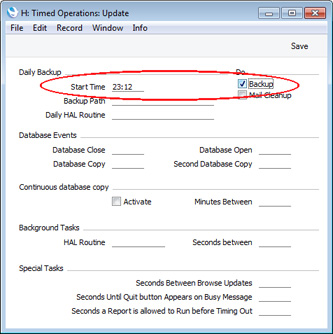Automatic Timed Back-ups
The importance of establishing a regular routine for backing up cannot be emphasised enough. Like all financial systems, Enterprise by HansaWorld uses a single file database in which all your data about customers, invoices, nominal ledger etc. is stored. If you lose that file, you have lost not just a single document, but all your accounting and customer information.
To make this task easier, Enterprise by HansaWorld contains a timed back-up feature allowing a database text back-up file to be created automatically every day. To specify when the back-up files are to be created, and where they are to be stored, follow the steps outlined below.
- Select 'Technics' using the [Module] button in the Master Control panel or the Ctrl-0 (zero) (Windows and Linux) or ⌘-0 (Mac OS X) keyboard shortcut. In multi-user systems, if you are working from a client machine, you should log in as a system administrator (i.e. as a Person that has access to the Technics module) as described here).
If 'Technics' is not included in the list of modules when you click the [Module] button in a single-user system, this will probably be because you have not granted yourself access to the Server module in the Configuration setting.
- Click the [Settings] button in the Master Control panel or use the Ctrl-S or ⌘-S keyboard shortcut. Double-click 'Timed Operations'. The following window appears:

- Set the Start Time (the time when the backup is to take place) to the appropriate time, when it is likely that no-one will be using Enterprise by HansaWorld. Use the 24-hour clock, and place a colon (:) between the hour and the minute. The back-up file will be created at the specified time, even if there are still users logged in to your Enterprise by HansaWorld system. However, such users will find the speed of operation to be much reduced while the back-up is being carried out. It is therefore highly recommended that you specify a time that is outside working hours, to minimise such inconvenience.
- Specify the Database Backup Path, which determines where on the server's hard disk the back-up files are to be saved. If you leave this field blank, the back-up files will be saved in the folder containing the Enterprise by HansaWorld application.
The following examples show the correct syntax for the Database Backup Path. You can use either \ or / as a separator between folder names under Windows, Linux and Mac OS X. Note that the separator appears as the final character in the path.
It is recommended that you save the back-up file in a folder or directory named "Backup" which should be in the folder or directory containing the Enterprise by HansaWorld application. All back-up files in this folder will be shown in a list of importable files if it becomes necessary to restore from a back-up. You can do this using a relative path:
- Backup/
If you want to store the back-up file somewhere else, use absolute paths with the following syntax:
- Windows
- c:/samplefolder1/samplefolder2/Backup/
- Mac OS X
- /samplefolder1/samplefolder2/Backup/
Note that if you make a mistake (for example, you make a syntax error or specify a non-existent folder) there is a risk that the back-up file will not be created.
- Finally in the Timed Operations setting, tick the Backup box to activate the timed back-up feature:

- Click the [Save] button in the Button Bar to save the back-up specifications.
Once you have set up the timed back-up feature as described above, a new back-up file will be created automatically every day at the same time. It will be given the name "TBYYMMDD.TXT" where "YYMMDD" represents the current date. The file will contain a back-up comment stating that it was created by timed back-up and showing the date and time this occurred.
---
In this chapter:
Go back to:
